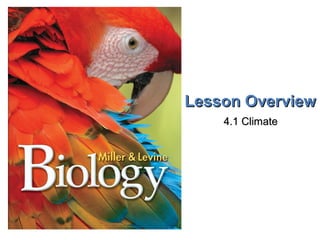
Climate Lesson Overview Explains Weather and Climate Factors
- 1. Lesson Overview Climate Lesson Overview 4.1 Climate
- 2. Lesson Overview Climate THINK ABOUT IT When you think about climate, you might think of dramatic headlines: “Hurricane Katrina floods New Orleans!” or “Drought parches the Southeast!” But big storms and seasonal droughts are better described as weather rather than climate. What is climate, and how does it differ from weather? How do climate and weather affect organisms and ecosystems?
- 3. Lesson Overview Climate Weather and Climate What is climate?
- 4. Lesson Overview Climate Weather and Climate What is climate? A region’s climate is defined by year-after-year patterns of temperature and precipitation.
- 5. Lesson Overview Climate Weather and Climate Weather is the day-to-day condition of Earth’s atmosphere. Climate refers to average conditions over long periods and is defined by year-after-year patterns of temperature and precipitation. Climate is rarely uniform even within a region. Environmental conditions can vary over small distances, creating microclimates. For example, in the Northern Hemisphere, south-facing sides of trees and buildings receive more sunlight, and are often warmer and drier, than north-facing sides. These differences can be very important to many organisms.
- 6. Lesson Overview Climate Factors That Affect Climate What factors determine global climate?
- 7. Lesson Overview Climate Factors That Affect Climate What factors determine global climate? Global climate is shaped by many factors, including solar energy trapped in the biosphere, latitude, and the transport of heat by winds and ocean currents.
- 8. Lesson Overview Climate Solar Energy and the Greenhouse Effect The main force that shapes our climate is solar energy that arrives as sunlight that strikes Earth’s surface. Some of that energy is reflected back into space, and some is absorbed and converted into heat.
- 9. Lesson Overview Climate Solar Energy and the Greenhouse Effect Some of the heat also radiates back into space, and some is trapped in the biosphere. The balance between heat that stays in the biosphere and heat lost to space determines Earth’s average temperature.
- 10. Lesson Overview Climate Solar Energy and the Greenhouse Effect Earth’s temperature is largely controlled by concentrations of three atmospheric gases—carbon dioxide, methane, and water vapor. These “greenhouse gases” function like glass in a greenhouse, allowing visible light to enter but trapping heat through a phenomenon called the greenhouse effect.
- 11. Lesson Overview Climate Solar Energy and the Greenhouse Effect If greenhouse gas concentrations rise, they trap more heat, so Earth warms. If their concentrations fall, more heat escapes, and Earth cools. Without the greenhouse effect, Earth would be about 30°C cooler than it is today.
- 12. Lesson Overview Climate Latitude and Solar Energy Near the equator, solar energy is intense, as the sun is almost directly overhead at noon all year. That’s why equatorial regions are generally so warm. The curvature of Earth causes the same amount of solar energy to spread out over a much larger area near the poles than near the equator.
- 13. Lesson Overview Climate Latitude and Solar Energy Earth’s polar areas annually receive less intense solar energy, and therefore heat, from the sun. The difference in heat distribution creates three different climate zones: tropical, temperate, and polar.
- 14. Lesson Overview Climate Latitude and Solar Energy The tropical zone, which includes the equator, is located between 23.5° north and 23.5° south latitudes. This zone receives nearly direct sunlight all year. On either side of the tropical zone are the two temperate zones, between 23.5° and 66.5° north and south latitudes. Beyond the temperate zones are the polar zones, between 66.5° and 90° north and south latitudes.
- 15. Lesson Overview Climate Latitude and Solar Energy Temperate and polar zones receive very different amounts of solar energy at different times of the year because Earth’s axis is tilted. As Earth revolves around the sun, solar radiation strikes different regions at angles that vary from summer to winter. During winter in the temperate and polar zones, the sun is much lower in the sky, days are shorter, and solar energy is less intense.
- 16. Lesson Overview Climate Heat Transport in the Biosphere The unequal distribution of heat across the globe creates wind and ocean currents, which transport heat and moisture. Earth has winds because warm air is less dense and rises, and cool air is more dense and sinks.
- 17. Lesson Overview Climate Heat Transport in the Biosphere Air that is heated by warm areas of Earth’s surface—such as near the equator—rises, expands, and spreads north and south, losing heat along the way. As the warm air cools, it sinks.
- 18. Lesson Overview Climate Heat Transport in the Biosphere In cooler regions, near the poles, chilled air sinks toward Earth’s surface, pushing air at the surface outward. This air warms as it travels over the surface and rises.
- 19. Lesson Overview Climate Heat Transport in the Biosphere These upward and downward movements of air create winds. Winds transport heat from regions of rising warmer air to regions of sinking cooler air. Earth’s rotation causes winds to blow generally from west to east over the temperate zones and from east to west over the tropics and the poles.
- 20. Lesson Overview Climate Heat Transport in the Biosphere Similar patterns of heating and cooling occur in the oceans. Surface water is pushed by winds. Ocean currents, like air currents, transport enormous amounts of heat.
- 21. Lesson Overview Climate Heat Transport in the Biosphere Warm surface currents add moisture and heat to air that passes over them. Cool surface currents cool air that passes over them. In this way, surface currents affect the weather and climate of nearby landmasses.
- 22. Lesson Overview Climate Heat Transport in the Biosphere Deep ocean currents are caused by cold water near the poles sinking and flowing along the ocean floor. This water rises in warmer regions through a process called upwelling.